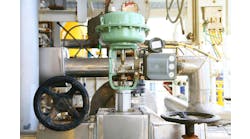From Eli Holman at GE:
Five years ago today, GE Fanuc Intelligent Platforms unveiled the first programmable automation controller, PACSystems, at "An Evening of Imagination" in Chicago, Illinois. At the time PACSystems was considered revolutionary in the control industry, one that enabled control convergence rather than mere integration of disparate parts and pieces. With one engine, coupled with a single development tool, users could take advantage of a powerful engineering environment for multiple applications.GE Fanuc Intelligent Platforms is “The Leader of the PAC”First Company To Introduce the Programmable Automation Controller Celebrates 5th Anniversary of Revolutionary Product Built on Open StandardsCHARLOTTESVILLE, VA, MARCH 3, 2008 Five years ago today, GE Fanuc Intelligent Platforms, a unit of GE Enterprise Solutions, unveiled the first programmable automation controller, PACSystems, at “An Evening of Imagination” in Chicago, Illinois.
PACSystems is built on open standards with a portable control engine, a single development tool and a universal engineering development environment. “Back then, PACSystems was considered revolutionary,” said Bill Estep, Vice President of GE Fanuc’s Control Systems Business. “It represented a revolutionary change in the control industry, one that enabled control convergence rather than mere integration of disparate parts and pieces. With one engine, coupled with a single development tool, users could take advantage of a powerful engineering environment for multiple applications.
“Through this innovation,” Estep continued, “ GE Fanuc PACSystems family addressed major engineering and business issues such as high productivity and communications openness. This flexible technology has helped users boost the overall performance of their automation systems, reduce engineering costs, and significantly decrease concerns regarding short- and long-term migration and platform longevity.”The acronym PAC was first coined in 2002 by Craig Resnick, Director of Research for ARC Advisory Group, as a way to help users of control hardware better define their needs and to give the leading control hardware vendors a term to more clearly communicate the capabilities of the their products. ARC is generally credited for popularizing the term within the manufacturing industry.
Since 2003, GE Fanuc has kept up a steady stream of innovations to the PACSystems family, introducing two distinct platforms – the PACSystems RX3i and RX7i – to ensure customers had the right capabilities to meet their needs. By combining new technology with existing hardware systems, the PACSystems family has provided a seamless migration path for users who have needed to upgrade their control platforms. The PACSystems RX7i addresses mid-to high-end applications, with large memory and bandwidth and distributed I/O to handle all major system requirements. The PACSystems RX3i is affordable, easy to integrate and provides unprecedented freedom in application portability across multiple platforms.“We’ve had a very successful five years with this product family and we keep improving it year after year,” said Bill Black, GE Fanuc Controllers Product Manager. “The PACSystems have evolved into unbelievably fast controllers. The RX3i’s CPU320 has an Intel M Class 1Ghz processor. The Control Memory Xchange is shared memory on a wire at 2.12 gigabaud. The system boasts transfer rates of 43 MB per second to 174 MB per second. And the High Speed Counter modules provide direct processing of rapid pulse signals up to 15 MHz for industrial control applications.“The RX7i’s super duty M class 1.8 GHz process has world class speed,” Black continued. “The VME64 backplane handles huge amounts of data – up to 14 mb per second.”“Manufacturers and OEMs make their controller selections based on factors which lead to the lowest total cost of ownership such as adherence to open industry standards, multi-discipline control functionality, and ease of integration,” said Craig Resnick, Research Director, ARC Advisory Group. “Manufacturers expect secure, reliable interoperability between their automation products and the rest of the their enterprise. However, the tightest interoperability solution exists when automation comes from a single product versus multiple products, with a single programming and engineering tool with common tagging and a single database, which has led to the rapid growth of the PAC multi-disciplined controller and the success of GE Fanuc’s PACSystems over the past five years.“Demand for PACs is projected to strengthen even further across all discrete, hybrid, and process industries,” Resnick continued, “as manufacturers and OEMs will increasingly specify and require PAC functionality for an ever growing number of applications.”
“We’ve got a strong base to move forward and we’re not stopping,” said GE Fanuc’s Estep. “Our PACSystems have helped so many customers with their automation needs over the past five years and we are not even close to ending this revolution. Our upcoming technologies and our experience will be key to helping customers far into the future.”
Leaders relevant to this article:



